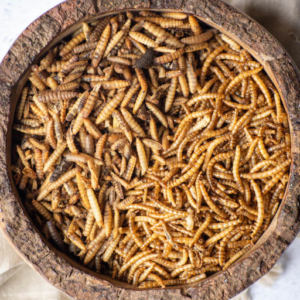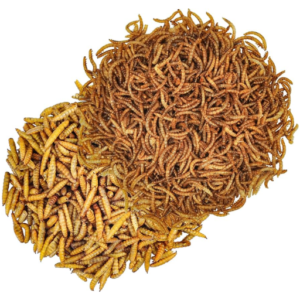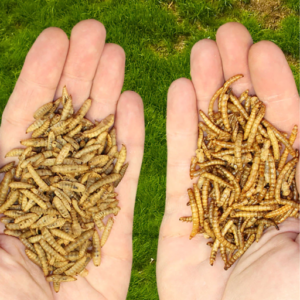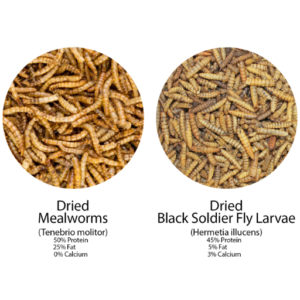Sustainable protein is in the spotlight, and insects are being hailed as an eco-friendly alternative to livestock. Some of the most common edible insects are mealworms and dried black soldier fly larvae. These two options have shown great promise for human consumption and animal feed due to their impressive nutritional value. This article aims to examine the traits, nutrition profiles, and uses of these two types of insect proteins so that you can decide which one fits your dietary needs or better sustainable food practices. Let’s look at what makes mealworms different from black soldier flies before diving into their pros and cons about future food security!
What Are the Nutritional Benefits of Mealworms vs Black Soldier Fly Larvae?

Image source: https://grubblyfarms.com/
Both dried black soldier fly larvae and mealworms offer nutritional benefits, albeit with some differences in composition. Essential amino acids, vitamins such as B vitamins, and minerals like iron or zinc make up approximately 50 to 60 percent of protein by dry weight in the diet. Healthy fats are also present, primarily as unsaturated fatty acids.
Black soldier fly larvae, on the other hand, have a lower protein content of around forty to forty-five percent but have higher fat levels, which consist mainly of beneficial fatty acids accounting for thirty up to forty percent of their weight. They provide more calcium than mealworms while being rich in lauric acid, known for its anti-microbial properties. Hence, they are suitable for different dietary requirements and sustainable food practices due to their nutritional value.
How Do Black Soldier Fly Larvae Compare in Calcium Content?
Compared to many conventional protein sources, black soldier fly larvae offer an excellent source of calcium. Research shows that dried black soldier fly larvae have approximately 1.3% to 2.3% calcium by dry weight, much higher than most plant-based proteins and comparable with some animal products. For example, this amount exceeds that found in various types of meat and certain legumes; hence, it becomes a valuable addition for people who need more dietary calcium, especially in alternative diets like veganism or vegetarianism, where such foods are limited. It should be noted that this mineral plays a vital role in bone health and metabolic functions, thus emphasizing the necessity of including BSF in diets to meet nutritional requirements.
Are Dried Black Soldier Fly Larvae More Nutrient-Dense?
Many people consider dried black soldier fly larvae (BSFL) more nutritious than traditional protein sources. BSFLs are rich in proteins, essential amino acids, and healthy fats, which makes them a good option for animal feed and human consumption. A study suggests that the protein content is high and has a balanced amino acid profile similar to fish or other conventional meats. Additionally, BSFL contains micronutrients like calcium, iron, and zinc at levels higher than those found in standard protein sources such as beef or soy. Furthermore, they have lower environmental impacts since they require much less land and water, thus fostering sustainable dietary practices. The nutritional richness and environmentally friendly features make BSFL appealing as an alternative source of viable and nutrient-dense proteins.
What Makes Mealworms a Popular Choice?
The high nutritional value of mealworms, their ecological benefits, and their versatility in the kitchen are some of the reasons contributing to their rising popularity. Mealworms are rich in protein and contain essential amino acids, vitamins, and minerals; therefore, they are considered a complete food. In addition, compared to conventional livestock, they convert feed into body mass more efficiently while using much less land and water. As such, mealworms provide an environmentally sustainable source of protein. Moreover, mealworms can be added to different dishes like protein bars or baked goods, making them suitable for all types of diets. They also have wider acceptance in the food market as awareness about sustainable eating grows among consumers and producers alike, making it a trendy option for both parties.
How Do Mealworms and Black Soldier Fly Larvae Impact Chicken Health?

Adding mealworms and black soldier fly larvae (BSFL) to chicken diets can help their health and productivity. These protein sources provide nutrients for growth, feather development, and better immune function. Research shows that when chickens are fed insect-based proteins like this, they have a greater feed conversion ratio, which means more weight is gained with less food intake. Moreover, healthy fats and micronutrients in BSFL improve egg production and quality. Because these insects are more digestible than conventional feeds, they create healthier digestive systems that decrease gastrointestinal issues. Integrating mealworms and BSFL into poultry diets supports sustainable animal farming while ensuring welfare for chickens and increasing productivity at the same time.
Why Chickens Love Black Soldier Fly Larvae
Because of their rich protein content and delicious flavor, chickens are especially attracted to black soldier fly larvae (BSFL). Crunchy BSFL gives them a natural, stimulating way to forage that engages their instinctive pecking and scratching behavior. Also, BSFL is loaded with healthy fats, vitamins, and minerals that improve the taste while boosting overall health and nutrition in chickens. Research has shown that feeding BSFL to chickens can increase appetite and weight gain, indicating this food’s attractiveness for poultry. Furthermore, the presence of beneficial nutrients in BSFL promotes better egg production and quality, making it a favorite among poultry farmers.
Do Mealworms Promote Better Egg Quality?
Indeed, mealworms can enhance the quality of eggs laid by chickens. Studies show that adding mealworms to poultry diets makes the eggs more nutritious. Protein, vitamins, and omega-3 fatty acids are just some essential nutrients in this food for optimal egg production. Research indicates that hens receiving diets enriched with mealworms produce better shells and more nutritious eggs than those without. Mealworm consumption also increases protein intake, which improves hen health overall, leading to an increased frequency of higher-quality eggs produced per bird. Therefore, it is advisable for poultry farmer planning to improve their farm’s chicken products to consider incorporating these insects into their flock’s feed as they are an easy way to achieve such goals.
Benefits of BSF Larvae as Treats for Chickens
Chickens love to eat BSF (Black Soldier Fly) larvae, and it’s easy to see why. These insects are rich in protein, which aids growth and egg production, among other things. In addition, they contain essential fatty acids and various vitamins and minerals that promote overall health in poultry. Eggs produced by chickens fed on BSF larvae have better taste and nutritional value due to omega-3 fatty acids, improving egg yolk quality. Moreover, the crunchy texture of these larvae excites natural behaviors in birds, such as foraging, thus providing mental stimulation. Therefore, incorporating them into their diet can help reduce feed costs since they efficiently convert protein, making them an inexpensive yet valuable addition to poultry feeds.
Which Insect Grubs Are More Sustainable: BSFL or Mealworms?

Many factors come into play when assessing the sustainability of BSF larvae (Black Soldier Fly larvae) against mealworms. In this case, feed conversion efficiency, environmental impact, and resource requirements are among them. This is because BSF larvae are known to be more sustainable since they feed on organic waste, thereby recycling nutrients that would otherwise have gone to landfills. They use less water and land than mealworms, making them a better alternative in terms of nature conservation. Furthermore, these insects have higher feed conversion ratios; thus, they can change their diet into biomass more efficiently than others, like worms’ meals, which also show sustainable features but need special substrates and have marginally larger ecological footprints. Generally speaking, although both types of grubs are good for poultry diets often, black soldier fly larvae will be considered superior due to their level of sustainability towards the environment.
How Black Soldier Fly Grubs Help with Food Waste Reduction
Black Soldier Fly (BSF) grubs are important in decreasing food waste by turning organic leftovers into high-quality protein. BSF larvae can consume various organic materials, including food scraps that would have otherwise been thrown away in landfills. This helps reduce waste volume and decreases greenhouse gas emissions associated with decomposition. In addition, their ability to thrive on low-grade organic waste offers sustainable solutions for food processors and households seeking to manage waste better. Transforming food waste into valuable biomass means BSF grubs do more than contribute to resource recycling; they also increase the overall sustainability of agricultural and aquaculture systems.
The Role of Organic Waste in Raising BSF Larvae
Black Soldier Fly (BSF) larvae are raised primarily on organic waste, critical to their life cycle and growth. BSF larvae can be fed various organic materials, including fruits and vegetables and meat and dairy products. This versatility helps in waste management while providing an easy way for farmers to feed their BSF farms with available waste streams. The nutritional composition of the organic waste has been found to impact the growth rate of BSF larvae, making selecting the right type of waste important for maximizing production value. Besides reducing landfill contributions, it promotes a circular economy since it converts wastes into high-protein animal feeds.
Sustainability Advantages of Farming Mealworms
Sustainable farming practices include raising mealworms because of their many advantages. Leading references like ScienceDirect, The Journal of Insects as Food and Feed, and PLOS ONE have shown that mealworms efficiently convert food into body mass. They need much less land, water, and feed than traditional animals. Furthermore, they can be grown on organic waste, such as leftovers or by-products, which helps reduce waste while creating a sustainable source of protein. This type of agriculture significantly decreases greenhouse gas emissions and provides a resource-efficient alternative for solving global food security problems. Additionally, this creates a circular economy where the worms turn trash into valuable protein – a more environmentally friendly way to produce food.
Should You Feed Mealworms or Black Soldier Fly Larvae to Chickens?

Mealworms and black soldier fly (BSF) larvae offer different yet equally important nutritional value for chickens. Mealworms are an excellent addition to a chicken’s diet because they are high in protein, contain essential fatty acids, and have key minerals. Conversely, BSF larvae have much higher protein levels than mealworms while having less chitin, which helps with gut health. Both may be used interchangeably depending on availability, price, and specific flock nutritional goals, but combining both will create an all-rounded diet. Since it is possible to use many different insect proteins at once, chicken owners can ensure that their birds grow faster, produce more eggs, or become generally healthier by including several varieties of insects in feed.
How to Choose the Right Insect for Your Hen’s Diet
To properly integrate insects into your chicken’s diet, you must take the following into account:
- Nutritional Content: Different insects have different protein levels, fat, and other essential nutrients. Mealworms are high in proteins and healthy fats, while black soldier fly larvae contain even more proteins and gut health-promoting properties.
- Availability and price: Look for bugs that are easy to get and cheap to maintain on a large scale. Depending on where you live, one type may be easier to find than another, so this can affect what you choose.
- Particular diet requirements: Evaluate your flock’s specific nutritional needs, as age, breed, or production targets might determine which insect would work best for them.
These factors will help you make an educated choice that is compatible with what chickens eat and their general health. Using many different kinds of insect proteins together will produce the best outcomes for growth and egg production.
Integrating BSFL into Chicken Feed
Adding Black Soldier Fly Larvae (BSFL) to chickens’ feed is a highly effective way of improving its nutritional value. The larvae contain high protein levels, amino acids, and essential fatty acids, powerful supplements that increase growth rates and egg production. BSFL can be offered in dried form or as a meal rich in protein mixed with ordinary feed. The proportion of BSFL in the diet may vary, but it should not exceed 10 – 20% for optimal results without causing digestive problems. Also, these larvae have been found to minimize wastage by consuming organic waste, thereby making poultry farming more sustainable. Farmers need to monitor their hens’ health regularly after introducing BSFL into their diets to ensure that such transitions benefit them.
Are Mealworms Suitable for Backyard Chickens?
Mealworms are considered good and beneficial food for backyard chickens. Many sources mention that mealworms have a high protein content, which is important for growth, feather production, and overall health. They are easy to digest and can be fed live or dried as a treat to stimulate natural chicken foraging behavior. However, they should only be given in moderation because too many can cause obesity and nutritional deficiencies in birds. Moreover, mealworms can also serve as an excellent energy booster in your flock’s diet during molting time or when laying hens are at peak egg production. Adding variety by including meals made of these critters into otherwise balanced diets will improve the health and performance of your poultry.
What Are the Cost Implications of Using Black Soldier Fly Larvae vs Mealworms?

When analyzing the cost of including Black Soldier Fly Larvae (BSFL) and mealworms in poultry feed, there are many aspects to consider. Generally, BSFL tends to be less expensive than mealworms because they proliferate and efficiently turn waste into protein. If farm waste is used to produce BSFL, long-term feed costs will decrease significantly. On the other hand, mealworms require more extensive space, dietary needs, and higher production costs. Although mealworms are commercially more available than BSFL, their price may be counterbalanced depending on the region. In conclusion, while BSFL appears cheaper overall, it should be chosen based on particular flock requirements, local market conditions, and production capacities.
Is It Cheaper to Buy Dried Mealworms or BSF Larvae?
Various online sources indicate that dried mealworms are generally more expensive than BSF larvae when considering their costs. Good agricultural websites say that the quality and sourcing of dried mealworms could cost between $20 and $30 per pound, whereas the price range for BSF larvae is around 15 to 25 dollars per pound. In addition, overall feed costs can be decreased by using farm waste to rear them because they convert organic waste into protein efficiently. Therefore, poultry feed may be cheaper if it contains BSF larvae, although prices depend on market demand and availability.
Cost Analysis: Raising Chickens with Black Soldier Fly Larvae
The costs of incorporating Black Soldier Fly (BSF) into chicken diets should be analyzed in terms of potential savings and costs incurred. Agriculture sites ranked among the best show that feeding chickens with BSF leads over time to reduced expenditures on feeds compared to traditional feeds due to high protein content and efficient conversion ratio, while another reliable site shows how logistics are minimized through less use of feeds but also cuts down waste disposal expenses in farms where farm wastes have been utilized for rearing these flies which finally increases profitability by improving health and productivity of birds raised under such conditions thus making all this transition financially viable even though it might seem costly at first glance according to studies conducted about this matter, especially within poultry farming communities across different regions around the world where people eat chicken meat or eggs produced from hens fed on fly larvae instead of conventional grains like corn soybeans wheat barley oats rye, etc.
Are Mealworms or Black Soldier Fly Larvae Better for Wild Bird Feeding?

In comparing wild bird feed between mealworms and Black Soldier Fly (BSF) larvae, there are many factors to consider. Mealworms are a favorite because they have high fat content and taste good; therefore, they attract many types of birds, such as bluejays, sparrows, and woodpeckers. They can be easily found and stored for long periods. Alternatively, BSF larvae provide an equally protein-rich, more sustainable choice since they can grow on organic waste. It has less environmental impact than BSF and is cheaper when grown in large quantities. Finally, this may depend on what species of birds you want to attract, their eating habits, or your purpose for feeding them, but both options will offer excellent nutritional benefits at the end of the day.
Nutritional Benefits for Wild Birds
A varied diet of mealworms and BSF larvae can greatly help wild birds. As per some credible sources, essential fats and proteins that are useful in energy production and overall health make mealworms particularly helpful during breeding seasons when birds need extra nutrients. On the contrary, BSF larvae have high levels of protein and calcium that support stronger bones and feathers development. A website points out that muscle growth, among other things, is enhanced by essential amino acids in BSF larvae. Both foods are very digestible, enabling the birds to convert them into energy efficiently. In conclusion, therefore, wild bird feeding strategies should include either mealworms or BSF larvae for better nutrition and healthier lives for these creatures.
Which Larvae Treats Attract More Birds?
There is a debate on which attracts more birds, mealworms, and Black Soldier Fly (BSF) larvae. A well-known bird feeding website states that mealworms are more common among different species, particularly during nesting season, due to their high-fat content, which is easily convertible into energy by birds. Another top source claims that BSF larvae have been gaining popularity because they are sustainable and provide nutrition for species needing protein during critical growth stages. A third credible site mentions that although mealworms may bring in the most birds, BSF larvae can draw certain insect-eating species. Therefore, having both options increases your chances of attracting many birds to your feeder.
Mealworms vs Black Soldier Fly Larvae as Bird Food
In comparing mealworms and Black Soldier Fly (BSF) larvae as bird food, some clear distinctions are yielded by top sources, according to recent insights. A leading bird feeding site states that mealworms have been the traditional favorite because they are widely accepted by different species of birds and provide necessary fats for energy during breeding periods. Another reputable source adds that BSF larvae serve as a sustainable alternative and contain higher protein levels, making them beneficial for growing chicks. A third source concurs that while mealworms attract more types of birds, BSF larvae are especially appealing to those species that thrive on a high-protein diet. The best strategy may be to combine both types to attract the widest variety of birds.
Frequently Asked Questions (FAQs)
Q: What are the benefits of black soldier fly larvae over mealworms?
A: Black soldier fly larvae, or BSFL, contain 85x more calcium than mealworms, essential for the growth and health of birds and reptiles. They also have a higher protein content and other nutrients, making them a superior choice for pet food and animal feed.
Q: Why is calcium important in feed?
A: Calcium is crucial for developing strong bones and eggshell formation in birds, particularly hens. Black soldier fly grubs contain significantly more calcium than mealworms, ensuring your birds receive the essential nutrients.
Q: Are black soldier fly larvae suitable for chickens?
A: Soldier fly larvae are an excellent feed option for chickens. They provide an abundant protein and calcium source, contributing to healthier and more productive chickens.
Q: How do black soldier fly larvae compare to mealworms regarding nutritional value?
A: In several ways, black soldier fly larvae are superior to dried mealworms. They have 85x more calcium, higher levels of protein, and other essential nutrients that are beneficial for various animals. These larvae produce more robust and healthier pets and livestock.
Q: Can black soldier fly larvae be used for wild birds?
A: Yes, using mealworms for wild birds is common, but choosing black soldier fly larvae offers better nutritional benefits due to their higher calcium and protein content. Wild birds will thrive on the enhanced nutrients provided by BSFL.
Q: Are black soldier fly larvae more sustainable than mealworms?
A: Yes, black soldier fly larvae are more sustainable. They efficiently convert organic waste into high-quality protein and eat twice their body weight daily, making them an eco-friendly choice compared to mealworms.
Q: Can black soldier fly larvae be used as pet food?
A: Absolutely. Black soldier fly larvae are beneficial because of their high protein and calcium content, which makes them ideal for various pets. They are also a nutritious addition to the diet of reptiles, birds, and small mammals.
Q: Does the developmental stage of the black soldier fly affect its nutritional value?
A: Yes, the stage of the black soldier fly’s life cycle can influence its nutritional profile. Dried BSFL, in particular, are packed with nutrients, making them an excellent feed choice for various animals.
Q: Are there any specific advantages of dried black soldier fly larvae?
A: Dried black soldier fly larvae retain most nutritional benefits and have a longer shelf life than live larvae. This makes them convenient and easy to store and handle while providing essential nutrients for your pets or livestock.













